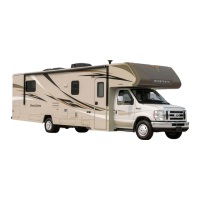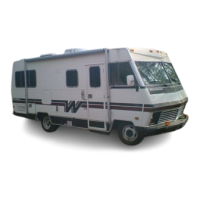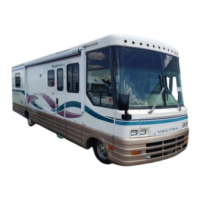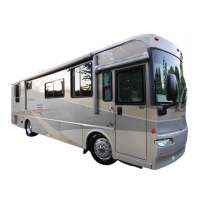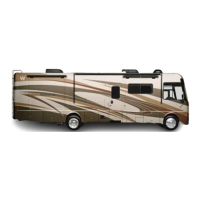
Do you have a question about the Winnebago Minnie Winnie 2015 and is the answer not in the manual?
| Manufacturer | Winnebago |
|---|---|
| Model | Minnie Winnie |
| Model Year | 2015 |
| Class | C |
| Width | 8' 5" |
| Horsepower | 305 hp |
| Fuel Type | Gasoline |
| Fuel Capacity | 55 gallons |
| Transmission | 5-speed automatic |
| Chassis | Ford E-Series |
| Gross Vehicle Weight Rating (GVWR) | 14, 500 lbs |
| Slide-Outs | 1 |
| Engine | 6.8L V10 |
| Fresh Water Capacity | 44 gallons |
| LP Gas Capacity | 18 gal |
| Generator | 4, 000 watt |
| Awning | Power |
Manual prepared to aid in proper care and operation of vehicle and equipment.
Alerts to precautions involving vehicle damage or personal safety risks.
Motorhome inspection by dealer before shipment, including road testing.
Familiarize with state/province and local regulations before traveling.
Recommend checking and adjusting front suspension and steering alignment after loading.
Information and assistance from dealer for operation, maintenance, and warranty repairs.
Inform NHTSA and Winnebago of defects causing crashes, injury, or death.
Label shows vehicle occupant and cargo capacity, seat belt positions, and water weight.
Label affixed to driver's area with VIN, manufacturing date, weight ratings, and tire/rim info.
Details on length, height, width, tank capacities, GVWR, GAWR, GCWR, and fuel capacity.
Forms for owner, vehicle, dealer, and service center details.
Guidelines for safe use of seats, seat belts, and sleeping facilities while the vehicle is in motion.
Pre-drive inspections and precautions for safe operation of the motorhome.
Safety warnings and precautions for handling and using propane gas systems.
Procedure to follow if a propane gas leak is suspected.
Information on the propane gas leak detector and its function.
Details on the CO alarm, its function, and testing procedures.
Precautions and maintenance for exhaust system to prevent CO entry.
Information on the smoke alarm, its power source, and testing.
Location, inspection, and use of the fire extinguisher.
Cautions regarding safe handling of electrical components and systems.
Guidelines for securing items and not exceeding weight limits.
General maintenance tips, including radiator cap and jack safety.
Instructions on operating escape windows and slider windows as exits.
How to use slider windows as alternate emergency exits.
Warning and precautions before operating slideout rooms.
Information on formaldehyde emissions and health effects in the vehicle.
Guidance on preventing mold growth and dealing with moisture.
Safety precautions for using the roof ladder and staying off the roof.
Procedures for handling a flat tire and advice on recovery towing.
Instructions for jump starting the engine using another vehicle or booster system.
Procedure to follow if the engine is overheating.
Information on adjusting driver and co-pilot seats.
How to fold down the dinette seat backrest cushion.
Guidelines for proper use, adjustment, and care of seat belts.
Information on properly installing and securing child restraint systems.
Information on the motorhome keys and obtaining duplicates.
How hazard warning flashers provide additional safety when stopped on the roadway.
Instructions for adjusting and cleaning power sideview mirrors.
Information on operating the dash air conditioner/heater and defroster.
Operating instructions for the radio and rearview monitor system.
Using the hand-held remote control for the radio.
Details on operating the radio, CD/DVD player, and rearview camera system.
Precautions for removing the interior engine cover.
Information on checking and maintaining the engine cooling system.
Importance of proper tire pressure for handling, wear, and fuel economy.
Information on factory alignment and the need for periodic checks.
Information on adjusting rear air helper springs for ride and handling.
Checking exterior lights for proper operation and troubleshooting blown fuses.
How the refrigerator operates on AC electric or propane gas.
Access to the rear of the refrigerator for inspection, maintenance, and service.
User guide for operating the range and oven.
Warnings about using gas appliances for comfort heating and ventilation.
User guide for complete operating instructions.
Information on the range hood vent, light, and filter maintenance.
Checking utility systems like water, propane, and battery levels.
Operating the water pump switch for the self-contained water system.
Information on operating the gas water heater and safety warnings.
Information on the water heater P-T valve and replacing the air gap.
Instructions for starting up and shutting down the propane gas furnace.
How the furnace thermostat controls the ducted roof air conditioner.
Location and cleaning recommendations for the air conditioner filter.
Information on the propane gas system components and how it works.
Recommendation to use straight propane for RV appliances.
Issues caused by air in the propane tank and how to purge it.
Safety devices and industry requirements for mobile propane gas equipment.
Legal restrictions and general safety precautions for propane use.
Information on the pressure regulator, its protective cover, and vent.
Causes of regulator freeze-up and how to avoid or thaw it.
How cold weather affects propane vaporization and potential pressure loss.
Cautions regarding safe handling of electrical components and systems.
Operation of the 120-volt AC system from shoreline or generator.
Connecting the external power cord to an outside utility source.
Using the flip-up passage in the power cord door.
Using the threaded port utility hatch for routing the power cord.
Protecting park wiring and vehicle power cord from electrical damage.
Location and function of the power converter and its panel.
How 120-volt circuit breakers protect components from overloads or shorts.
Description of standard household electrical outlets and an exterior outlet.
How GFCI outlets protect against electrical shock.
Instructions for using the 120-volt generator.
Information on generator operation, care, and maintenance.
Using the hourmeter to determine when periodic maintenance is due.
Components of the 12-volt DC system: chassis battery, house batteries, converter.
Function of the chassis battery for starting and accessories.
Deep-cycle batteries for 12-volt equipment, charged by the alternator.
How to disconnect house batteries to avoid drain during storage.
Best defenses against sulfating and insufficient charge for batteries.
Recommends disconnecting chassis battery to avoid discharge during storage.
How fuse or breaker panels protect 12-volt circuits from overloads or shorts.
Location of the fuse panel and information on fuse types and ratings.
Provides water to sink, shower, toilet, and water heater from tank or city water.
Supplies water from fresh water tank when not connected to city water.
Information on the cleanable strainer to capture tank-borne particles.
Location and operation of the water pump switch.
Procedure for priming the water system for the first time.
Procedure for disinfecting the potable water system using chlorine solution.
Method for ensuring continuous sanitation of the fresh water tank.
Explanation of water dripping from shower faucet after use.
Operating the RV toilet and important 'Don'ts'.
Description of self-contained drainage system with two holding tanks.
Step-by-step procedure for dumping black and gray waste water tanks.
Connecting to an on-site sewage hook-up and managing dump valves.
How the 12-volt waste pump disposes of gray holding tank waste.
Procedure for dumping black and gray waste water tanks.
Information on holding tank heaters for use in freezing temperatures.
How to open and close water drain valves for storage or sanitizing.
Valves for winterizing waterlines using RV antifreeze.
Method for winterizing the water and plumbing system of the coach.
Procedure for dumping and cleaning holding tanks.
Chart showing locations of drain valves for various models.
Instructions for angling the TV using the swivel/telescoping mechanism.
Connecting and operating the DVD player.
Operating instructions for the CD/DVD player and stereo radio.
Turning on the antenna booster and tuning the TV.
Connecting and using the park cable input.
Raising, rotating, and lowering the TV antenna.
Description of the stationary omnidirectional TV antenna design.
Information on the built-in TV signal amplifier and its power switch.
Exterior receptacle for connecting a TV for outdoor entertainment.
Sleeping facilities are not intended for use while vehicle is in motion.
Information and safety precautions for using the bunk ladder.
Step-by-step instructions for attaching the bunk ladder.
Instructions for converting the sofa to a bed and back to a sofa.
Converting the dinette to a bed and back to dinette seating.
Instructions for converting the dinette to a bed and back.
Converting the mini dinette/couch to a bed and back.
Steps to convert the dinette into a couch.
Steps to convert the couch back into dinette seating.
Converting the U-shaped dinette into a bed and back to dinette configuration.
Procedure for converting the U-shaped dinette into a bed and back.
Operating and adjusting manual roller shades for heat and light control.
Information on wood types, grain, stains, and warranty coverage.
Ensuring the ignition key is on and park brake is set to operate slideout rooms.
Operating slideout rooms using 12-volt DC motorized mechanisms.
Procedure for extending slideout rooms, including pre-checks.
Procedure for retracting slideout rooms, including pre-checks.
Recommendations for retracting slideout rooms during extreme weather.
Troubleshooting battery voltage or circuit breaker problems with slideout rooms.
Procedure for manual override if slideout room fails to retract.
Locating and disengaging the slideout motor.
Cleaning and maintaining slideout room seals.
General care for slideout rooms, including seals and floors.
Importance of inspecting and maintaining sealants to prevent water entry.
Precautions for keeping the motorhome's exterior finish looking its best.
Recommendations for parking to protect the exterior finish.
Precautions to take while driving regarding exterior finish.
Recommendations for washing the motorhome to prevent finish damage.
Inspecting the exterior fiberglass shell for cracks and damage.
Maintenance steps for preserving the life of pressure-sensitive graphics.
Guidelines for cleaning plastic parts without causing damage.
Cleaning polycarbonate lenses on exterior lamps.
Routine vacuuming and cleaning of fabrics and carpet.
Cleaning wooden and vinyl wood paneling for cabinetry.
Cleaning decorative vinyl wall paneling with mild detergent.
Preserving beauty and ease of cleaning for tables and countertops.
Care and cleaning instructions for the stainless steel galley sink.
Care and cleaning instructions for the acrylic galley sink.
Refer to manufacturer's manuals for care and maintenance.
Recommendations for maintaining the beauty of vinyl flooring.
Tips for protecting flooring from damage and wear.
Methods for treating various types of stains on flooring.
Cleaning mild soap and warm water for tub and shower walls.
See Galley Sink instructions for care and cleaning.
Cleaning windows, removing ice, and lubricating locks/hinges.
Steps to prepare the motorhome for storage.
Steps to take when removing the motorhome from storage.
Consult chassis manual for operating safety and service recommendations.
Recommendations for normal recreational use maintenance intervals.
Guidelines for distributing cargo weight to avoid exceeding GVWR or GAWR.
How to weigh the loaded coach at a commercial scale.
Method for distributing cargo to avoid overloading tires.
Information on hitch capacity, tongue weight, and towing guidelines.
Diagrams and information on connecting trailer or tow vehicle wiring.
Definitions and explanations of GVWR, GAWR, and GCWR.
Classification of trailer hitches based on GVWR and vertical tongue load.
Further information on operating the manual awning.
Location of the power awning switch.
How to extend or retract the awning using the power switch.
How the ignition lockout system affects awning operation.
Ensuring exterior storage compartment doors are properly latched.
Storage of roof ladder extension and tools.
Safety precautions for using the roof ladder.
Operating horizontal slider windows and vertical slider windows.
Dealing with condensation and humidity during extended occupancy.
Opening windows and roof vents to circulate air and reduce condensation.
Using fans and vents to remove water vapor from cooking and bathing.
